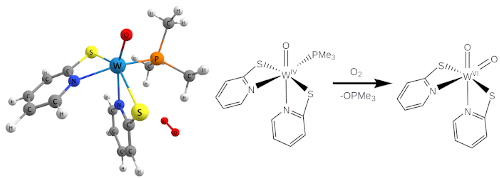Speaker
Description
Biology offers a source of inspiration for transformations of special relevance namely the activation of small molecules like O$_2$, CO$_2$, N$_2$, etc. One such example is acetylene hydratase which contains a formally W(IV) active site containing aromatic 1,2-dithiolate ligands, a cysteine residue, and an aqua ligand. This active site is generally called metallopterin, or more appropriately in this case tungstopterin.
Recently,$^1$ a stoichiometric oxygen activation was reported by Mösch-Zanetti and co-workers wherein a formally W(IV) complex {WO(6-MePyS)$_2$[P(CH$_3$)$_3$]} (6-MePyS = 6-methylpyridine-2-thiolate) can effect a stoichiometric di-oxygen activation and cleavage. This complex is inspired by acetylene hydratase but instead of the aromatic dithiolate coordination it contains pyridine-thiolate as a ligand.
In this talk a mechanistic proposal will be given for this reaction. A density functional protocol [DKH2-PBE0-D4/x2c-TZVP(x2c-SVP)] will be used as a quantitative tool to evaluate barrier heights and free energies of intermediates in order to put forward quantum chemically viable routes for this transformation.

- Ćorović, M. Z.; Belaj, F.; Mösch-Zanetti, N. C., Inorg. Chem. 2023, 62 (14), 5669-5676.
